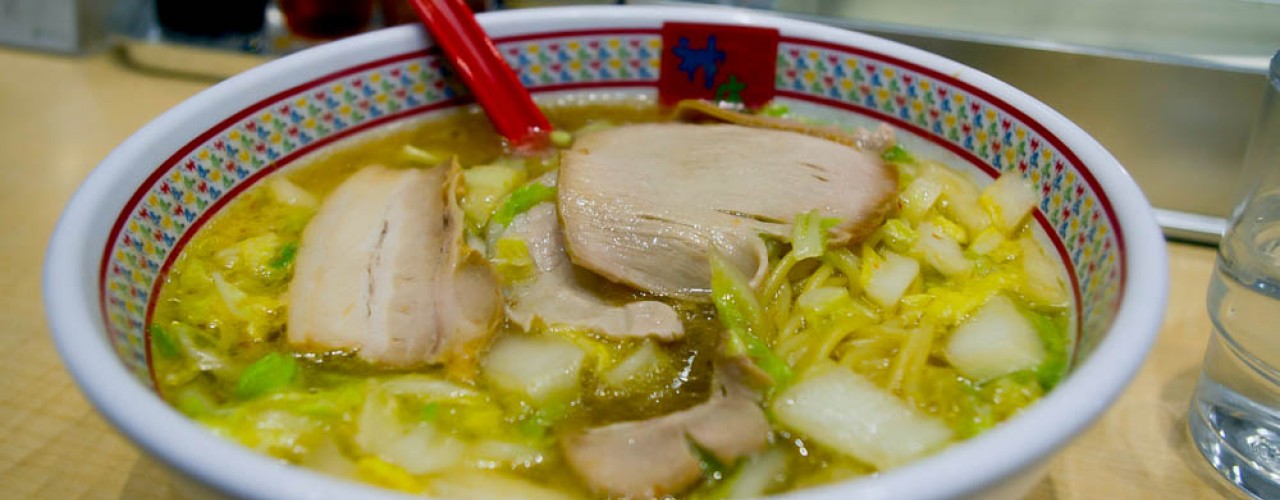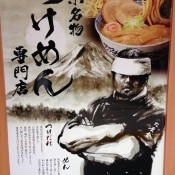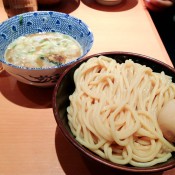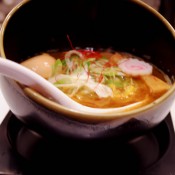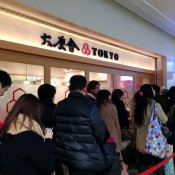Guide to Ramen
If you hail from North America or Europe you might be a bit confused with all the hype around one seemingly simple Japanese noodle dish—ramen. Maybe you've picked up a package of ‘instant noodles’ that bare the same name, and can’t really understand why people are constantly obsessing over the best place to score "authentic" ramen. So what is ramen anyway? If that's something you've always wondered we've got you covered in our guide that explains what this magical noodle dish is all about and why so many people love it.
Where did it come from?
Ramen is known as a Japanese noodle dish, however it actually originated in China. There’s a lot of debate about the origins of the word, but what is clear is how ramen came to be one of the most famous foods in all of Japan. After World War II when Japanese troops were returning from China they brought back with them the love of this Chinese street food. Around the same time flour became readily available to the Japanese making it easy for people to recreate the noodles they experienced in China. This is the start of a mass phenomenon that would build into what we have today which is a serious ramen culture.
Why you should care?
If you’ve never had the opportunity to have really good ramen you probably think the people waiting in line for hours, and ranting on internet forums about slurping these noodles are nuts—but you’d be wrong. Ramen is a comfort food to many, an addiction to some, and despite the cheap price tag actually requires a lot of work to create a truly great bowl of ramen. The savory broth is complex and flavorful, and the chewy noodles make the whole combination extremely satisfying—which is exactly why it’s one of the most popular dishes in all of Asia.
Just like pizza in New York, it’s unlikely you’ll ever get a straight answer on who makes the best bowl of ramen, as everyone has their favorites. We’re not joking when we say ramen is a serious obsession for a lot of people, the Ramen Museum in Osaka actually gets more visitors per year than the Japan National Museum—so clearly there’s something about these noodles in broth that gets people excited. Check out this bad ass ramen chef poster on Tokyo Ramen street—clearly ramen chefs are celebrities in this city.
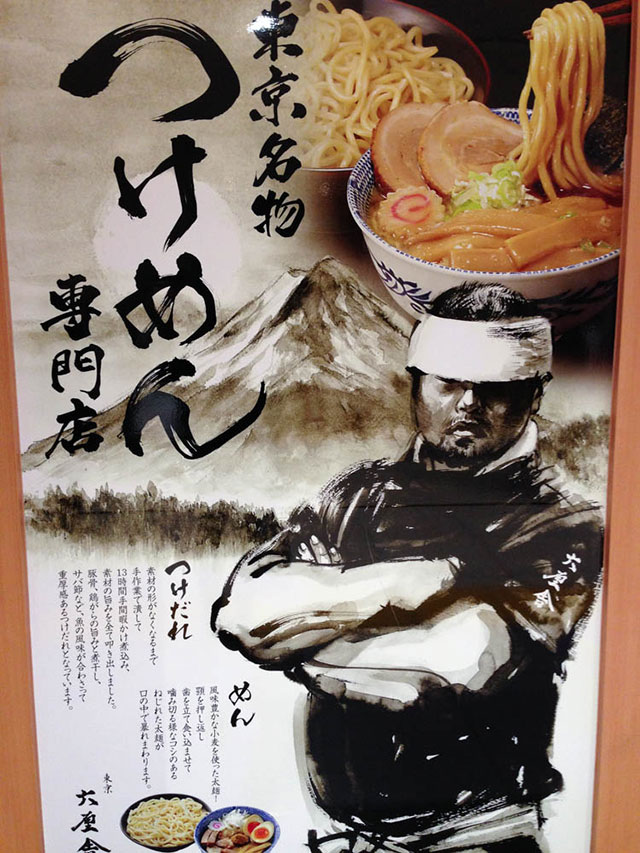
What is ramen?
To breakdown it down in very simple terms, ramen are noodles that are served with soup broth—however, it's anything but simple. That definition really only scratches the surface of this extremely popular dish. Ramen technically consists of two parts, broth and noodles, but there is a lot more to know than just that. Ingredients toppings, seasonings and the way the broth is cooked are all factors that make each bowl of ramen distinct. Here’s a bit of what you need to know.
Noodles:
The noodles used in ramen are of Chinese descent and consist of only four ingredients: flour, salt, water and a mineral called kansui, which is essentially a type of alkaline mineral that is naturally found in some water. This last ingredient is responsible for the yellow hue of the finished noodle, and although some ramen joints do use eggs in their recipe this isn’t the typical, or traditional way to make them. These ingredients create a dough that is either rolled out and cut into thin strips by a machine or, hand pulled or cut, which is usually how you’ll find them at authentic, lineup-worthy ramen restaurants. The art of making a good noodle is a skill that not all posses and a key piece of the ramen obsessession.
Broth:
When it comes to ramen broth, there are a few things you need to know. Not all broths are created equally, and the type can change the taste of the ramen dramatically. Some are thick and others are thin. Some are creamy and buttery, while others are salty and tangy.
There are actually four different types of broth base, each with its own unique flavor. In general all broths are created from stock, usually chicken, pork, or fish, with different ingredients added to create distinct flavors. Although there are four main broth types, the worldwide popularity of ramen means you’ll find a lot of innovative spin-off flavors at trendy ramen shops, but they are usually all derived from these four base types.
Shōyu:
Shoyu broth is the most common type of broth used in Tokyo. The word Shōyu is Japanese for soy sauce, so it’s no surprise that the main base is soy sauce combined with either chicken or vegetable stock. This type is clear with a brown coloration due to the soy sauce.
Shio:
Shio which means salt, is another clear broth that is yellow in color. This broth is made with a chicken or pork base and a ton of salt. If you’re trying to avoid sodium, this might not be your go-to ramen. This style of broth typically contains a lot of seaweed and dried seafood, and first made was in Hakodate Japan, where it's still home to some of the best Shio ramen in the world.
Tonkotsu:
Tonkotsu broth comes from Kurume Japan and is made from slow cooked pork bone, fat, and collagen. This broth is creamy, and thick resembling a runny gravey. It's known to many as the ultimate comfort food on cold days. You know you’re eating Tonkotsu broth when the soup is a opaque white cloudy color, and the texture is creamy and buttery.
Miso:
Miso broth was developed in Hokkaido Japan during the 60’s, and as you can guess from the name, contains a large amount of miso as the main flavor ingredient. Although vegetarians might be excited about this prospect, more often than not the stock used for miso broth is meat based and pork lard is also used to thicken it.
Tsukemen:
You’ll probably come across the term Tsukemen on some ramen shop menus, which literally means dipping noodle and if you order this you’ll get ramen broth and noodles in separate bowls With this dish you are meant to dip your noodles in the broth as you eat them, giving you control over how much soup is on each noodle. The noodles are cooked and cooled before they are served to you and keeping them separated from the broth prevents overcooking in the hot soup.
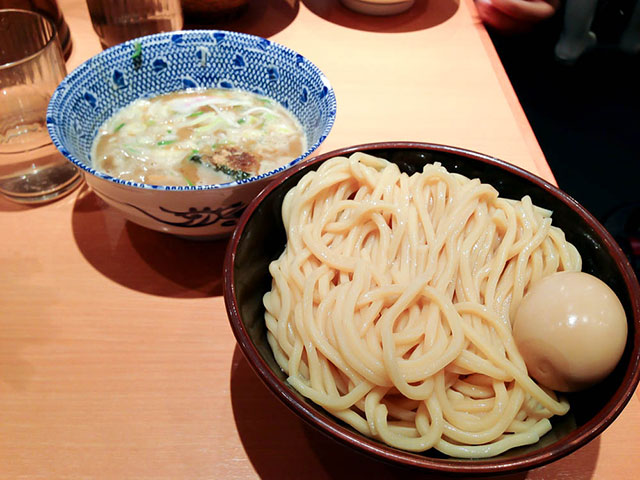
Toppings:
To each of these broths a myriad of toppings are added such as bamboo shoots, sliced pork belly, leeks, onions, cabbage, sesame, garlic, beef, chili spice, dried fish and seaweed, and of course a perfectly cooked egg. The toppings vary from shop to shop but are some of the standard offerings. The toppings in conjunction with the noodles and broth create a complex, and savory meal that is nothing like your run-of-the-mill grocery store fast food. Good ramen is always made with fresh ingredients and prepared with serious attention to detail.
How to eat ramen without looking stupid?
Well, stupid is a harsh word, but there is a chance if you didn’t grow up with chopsticks in your hand eating ramen might feel a bit scary. The thought of eating slippery noodles and hot soup with sticks might seems impossible—like you might end up with 3rd degree burns from splashing broth. Well not to worry, eating ramen isn’t all that hard. Ramen is served with chopsticks and a spoon, which you can use as an aid for the liquid and noodle transportation if needed. With your chopsticks armed in one hand and the spoon in the other you have the weapons you need to attack. Bend over slightly so you don’t have such a long distance between you and the soup and use your chopsticks to pull a few noodles from the soup and into your mouth. Once you’ve got the noodles in your mouth slide your chopsticks down the noodle close to the broth so you can control the splatter from the rest of the noodles submerged in the soup. Now slurp the noodles up into your mouth guiding them with your chopsticks. Keep in mind while eating ramen slurping is not only acceptable, it’s necessary. Slurping is thought of as a form of appreciation in Japan, and it’s a handy way to cool down the noodles due to the extra air you’re inhaling.
For some, who have been told to never slurp, this can feel weird, but rest assure it isn’t the least bit rude. If you’re having a hard time controlling the splash from the broth try using pulling your noodles out of the broth with your chopsticks, resting the bottom of the noodles on the spoon while you slurp them up. Even with all these tips sometimes splashes are inevitable, even for long time ramen eating masters. In a lot of ramen shops you’ll find handy bibs you can throw around your neck to keep your shirt clear of any renegade soup splashes. At this point you’re probably thinking that you’re going to look like a total amateur, but not so, in Tokyo a lot of businessmen rock the bib to avoid showing up at the office covered in their lunch.
The order of which to eat first is also debated among many ramen lovers. Do you scarf the toppings and noodles first saving the soup until the end? Or alternate between to get a good balance? Either way it’s usually best to eat the soup last so you can fill up on the noodles and toppings first, but there are no real rules set in stone, it’s really up to your preference. When all you have is a bit of liquid at the bottom of your bowl you can use the spoon to scoop up the last of the salty goodness or, if you’re at a casual joint, drink it from the bowl as you would with the last of your am breakfast cereal.
You convinced me! So where do I get the best Ramen?
Obviously Japan is your best bet to find the highest concentration of amazing ramen joints, but most major cities now have a few places where you can get a killer bowl of ramen to satisfy your craving. Check out some of the best ramen shops in our favorite cities.
Tokyo
-
Ivan
-
Rokurinsha
-
Ramen Street
Tokyo Ramen Street at Tokyo Station features the best ramen shops in all of Tokyo all under one roof. Space is by invitation only, only to the best ramen shops in Japan. The lineups are fierce but you're sure to get a great bowl from just about any of the places you end up at.
Side note: If you’re a vegetarian traveling to Tokyo looking for ramen, you’ll often be disappointed with your options. Check at Kagetsu which has recently added a special to the menu featuring low cal option made with veggie broth—a tough thing to find in a city that loves pork and chicken.
New York
-
Ippudo Ny
-
Totto Ramen
Paris
-
Kotteri Ramen Naritake
London
-
Shoyu
And if the craving strikes you and you’ve got nothing planned just look for the ramen place with the longest line and rest assure that you’ll be in good hands.

